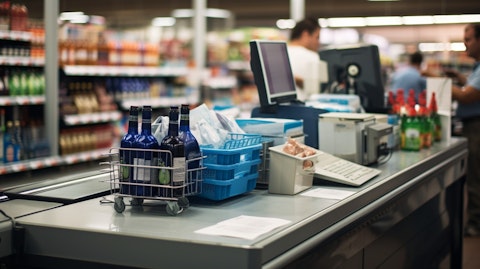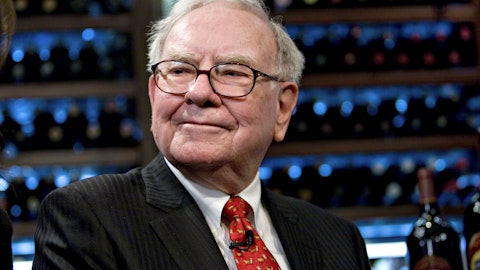The Kroger Co. (NYSE:KR) Q3 2023 Earnings Call Transcript November 30, 2023
The Kroger Co. beats earnings expectations. Reported EPS is $0.95, expectations were $0.9.
Operator: Good morning, and welcome to The Kroger Co. Third Quarter Earnings Conference Call. [Operator Instructions] Please note, this event is being recorded. I would now like to turn the conference over to Robert Quast, Senior Director, Investor Relations. Please go ahead.
Robert Quast: Good morning. Thank you for joining us for Kroger’s third quarter 2023 earnings call. I am joined today by Kroger’s Chairman and Chief Executive Officer, Rodney McMullen, and Chief Financial Officer, Gary Millerchip. Before we begin, I want to remind you that today’s discussions will include forward-looking statements. We want to caution you that such statements are predictions, and actual events or results can differ materially. A detailed discussion of the many factors that we believe may have a material effect on our business on an ongoing basis is contained in our SEC filings. The Kroger Company assumes no obligation to update that information. After our prepared remarks, we look forward to taking your questions. In order to cover a broad range of topics from as many of you as we can, we ask that you please limit yourself to one question and one follow-up question if necessary. I will now turn the call over to Rodney.
Rodney McMullen: Thank you, Rob. Good morning, everyone, and thank you for joining us today. Before we begin, I’d like to take a moment to outline our discussion topics this morning. I will begin by covering the current retail environment and how the strength of Kroger’s value creation model is supporting earnings growth and generating strong free cash flow. Then, Gary will cover our financial results and guidance for the remainder of the year. Finally, I will conclude with an update on our proposed merger with Albertsons, before we open it up for questions. Now, turning to our third quarter. Kroger’s third quarter results highlight the strength and diversity of our business model in a challenged operating environment. A strong fuel performance and growth in our alternative profit businesses supported continued adjusted net earnings per diluted share growth.
As consumer spending tightens, we are focused on providing customers with exceptional value by maintaining our long-term commitment to lower prices, personalized promotions and rewards. We are growing households and increasing loyalty, positioning Kroger for sustainable future growth. Customers are managing many economic factors that are pressuring their spending, including higher interest rates, reduced savings, and fewer government benefits, including SNAP. Although inflation is decelerating, customers are still adjusting to the impacts from eight consecutive quarters of broad and significant inflation. During the quarter, Kroger grew higher income households once again as our attractive mix of quality, value and convenience continues to drive engagement.
By buying larger packs, more fresh items and more premium Our Brands products, these households are more profitable. As we’ve seen over recent quarters, our customers are actively looking for value, and our budget-conscious customers are under more significant spending pressure. We are also looking for ways to support customers with additional value, including in-store displays with everyday staples at low price points. We’ve seen a great response from all customers to these offers. But engagement from our budget-conscious households has been especially strong. Customers purchasing these offer items are making more trips and buying more units, not only recognizing the value with these displays, but the value across the entire store. To help more customers manage their budget, we are only deepening our commitment to deliver exceptional value for our customers.
Our personalized promotions are an increasingly critical way for customers to save on items that matter most to them. We are applying analytics to Kroger’s unmatched purchase data to strike the right balance between the depth and breadth of promotions. To ensure customers were able to enjoy a memorable Thanksgiving, for example, we created a meal bundle that served a group of 10 for less than $5 per person, which represents a lower price than last year. We have a long history of delivering value to our customers by providing a broad assortment of fresh foods at low prices through our unique omnichannel shopping experience. We achieved our 10th consecutive quarter of total household growth and increased loyal households even faster, positioning Kroger for sustainable future growth.
Now, I’ll provide more details about how our go-to-market strategy is delivering for our customers. Starting with seamless. [Technical Difficulty] Our digital business delivered a strong third quarter with double-digit growth in both our pickup and delivery businesses. Multiple tailwinds are driving our sales momentum, including growth in both households and visits. Our new two-hour pickup service available in more than one-third of our stores also contributed to our success in the quarter. To become the online food retailer of choice, we are focused on delivering best-in-class fulfillment. Our teams improved key customer experience metrics in pickup, increasing fill rates and reducing wait times during the quarter. This resulted in an improved net promoter scores.
Our customer fulfillment centers again led our delivery growth, where we continue to rapidly increase households. Our delivery customers enjoy the convenience of on-time refrigerated delivery directly to their doorstep with zero compromise on freshness, quality, and value. Turning to personalization. Investments in our personalized capabilities ensure we are meeting elevated customer demand for savings and enables us to deploy promotional dollars more effectively. Digital offers have increased compared to last year and our personalization capabilities have resulted in even more significant increase in redemptions, driving loyalty and increasing digitally-engaged households this quarter by 13%. Digitally-engaged households are incredibly valuable to our model as they are more loyal, spend nearly 3 times more with us, and accelerate growth in our alternative profit businesses.
Now, I’d like to share more about how our diversified business model supported earnings growth this quarter and gives us confidence in our ability to navigate the environment ahead. Starting with our alternative profit businesses. Growth in alternative profit businesses remained strong in the third quarter with balanced growth across the portfolio. The strength of our seamless ecosystem and elevated digital engagement is having a flywheel effect, creating the traffic and the data needed to drive growth in Kroger Precision Marketing, a higher-margin profit stream. Recently, we celebrated the sixth anniversary of KPM. This quarter, KPM made an important step in its journey to become the most trusted and transparent media company. By activating ad buying platforms, we are offering more self-service solutions to meet clients where they are today, providing advertisers more direct access to custom Kroger audiences.
This first iteration has already launched, and KPM expects to expand to other buying platforms in the future. These new innovative features will help accelerate KPM’s impressive growth by allowing advertisers to reduce waste and enhance measurement tools. Kroger Health had a strong quarter that exceeded our internal expectations and helped drive sales and profit growth. Our decision to terminate our agreement with Express Scripts reflects our commitment to making decisions that we believe are in the best long-term interest of our customers and shareholders. Our teams have done an excellent job retaining patients and utilizing our pharmacists’ extra capacity to devote more time to patient care, including growing our number of vaccinations. Gary will provide more on the financial impact of this later.
During the quarter, we continued to see rapid growth in GLP-1 drugs in our retail pharmacies. While the long-term impacts of these drugs on customer buying habits are unknown, Kroger’s ‘Food as Medicine’ philosophy positions us well to support our customers’ health and wellness goals. Our comprehensive approach includes healthcare services, professional dietitians, and proprietary tools like our nutrition rating app, OptUP, which are all designed to support healthy living and to do so holistically. While we pride ourselves on data and insights, the patient data in our pharmacy operations is separate from our customer loyalty data and is protected by privacy laws. We are committed to using our data in an appropriate manner while not jeopardizing customers’ trust.
For now, we have not seen any major macro shifts in customer eating habits or spending behaviors. Food trends are constantly evolving, and we are committed to offering products that meet our customers’ needs. For customers looking to adopt healthier habits with or without the help of these drugs, we are well-positioned to provide important healthcare services and healthy food options. At Kroger, our purpose is to feed the human spirit, and I’m so impressed by the many ways our associates bring this to life every day in the ways they support our customers and each other. We know when associates are connected to our purpose, they feel connected to Kroger. Our annual Kroger Wellness Festival is just one example of living our purpose. This festival is one of the nation’s largest health and wellness events, showcasing more than a 150 experiences and food offerings.
Sponsors and celebrities joined Kroger in hundreds of thousands of visitors to share our vision for better physical, mental, and emotional health for families. It was wonderful to see the level of support and participation in this important mission. Also this quarter, we released our annual ESG report, which highlighted Kroger’s significant progress on our ‘Zero Hunger Zero Waste’ journey to expand access to affordable, fresh, and healthy food, and to reduce waste, especially food waste, across our footprint. Since we launched ‘Zero Hunger Zero Waste’ in 2017, Kroger has donated more than 3 billion meals to feed hungry families, including more than 1.3 billion to fight food insecurity and nearly 600 million pounds of surplus food to our food bank partners.
I am so proud of our teams and their efforts to reach these incredible milestones. Our associates are the driving force behind our success by delivering an outstanding customer experience and helping make the holidays even more special for our customers. We facilitate this through our long-standing commitment to invest in associate wages and benefits and training tools to advance their career growth. Feed Your Future, our continuing education benefit, is one of the important ways we make Kroger a place where associates come for a job and discover a career. This benefit provides up to $21,000 lifeline, and it’s helped almost 6,000 associates this year alone, with approximately 90% of these participants being hourly. Our focus on development is contributing to strong improvements in retention, which includes associate continuity and a more consistent customer experience.

With that, I’ll turn it over to Gary to take you through our financial results. Gary?
Gary Millerchip: Thank you, Rodney, and good morning, everyone. Kroger’s third quarter results demonstrate the resilience of our value creation model. The investments we have made over recent years to strengthen and diversify our business are allowing Kroger to navigate a challenged environment, characterized by tightening consumer spending and food-at-home disinflation. We achieved adjusted earnings per share growth of 8% this quarter, while also providing greater value for our customers, higher wages for our associates, and investing in strategic initiatives that will support future growth. This was made possible by our teams delivering strong performances across our margin expansion initiatives, fuel, alternative profit businesses, and health and wellness.
Our year-to-date results keep us on track to achieve adjusted earnings per share growth in 2023, building on record results over the prior three years. I’ll now provide more detail on our third quarter. Identical sales without fuel decreased 0.6%. Underlying growth would have been positive 1% adjusting for the effect of our terminated agreement with Express Scripts. Similar to the first two quarters of the year, the terminated agreement with Express Scripts had a positive effect on our FIFO gross margin rate excluding fuel and a negative effect on the OG&A rate excluding fuel and adjustment items. The overall net effect on operating profit was slightly positive. As a reminder, we will begin to cycle the impact of Express Scripts at the start of the new calendar year.
Turning back to identical sales without fuel. As Rodney shared earlier, our seamless ecosystem is a critical component of our growth strategy, building customer loyalty and fueling our alternative profit businesses. Digital sales were a highlight in the quarter, growing 11%. Our overall sales continue to be affected by industry-wide disinflation. Inflation ended quarter three in the low-single digits, approximately 270 basis points lower than the second quarter. Towards the end of the quarter, we saw inflation decline at a slower pace, and we would expect this trend to continue in the fourth quarter with inflation remaining positive at the year-end. Encouragingly, units have shown signs of improvement as inflation has decelerated, and we have sequentially improved units for four straight quarters.
However, unit growth rates have lagged the rate of inflation decline and have not improved at the pace we would have expected. As a team, we are laser-focused on returning to unit growth and expect improvement in volumes to continue for the balance of the year. Gross margin was 22% of sales and our FIFO gross margin rate excluding fuel increased 3 basis points compared to the same quarter last year. During the quarter, we increased investments in pricing and promotions to deliver greater value for customers, and we were able to successfully fund these investments by continuing to execute our long-term margin improvement plan, including Our Brands optimization, sourcing efficiencies and supply chain improvements. Shrink was a headwind to gross margin during the quarter, primarily due to the continued rise in industry-wide theft and organized retail crime.
We are investing in initiatives to mitigate shrink and protect our associates and customers in our stores. Looking ahead, we would expect these same factors that influence gross margin in quarter three will drive a similar outcome for gross margin rate in the fourth quarter. During quarter three, we recorded a LIFO charge of $29 million compared to a charge of $152 million for the same quarter last year. This reduction was due to inflation returning to low-single digits compared to double-digit growth experienced last year. Kroger’s OG&A rate increased 32 basis points excluding fuel and adjustment items. The increase in OG&A rate was driven by planned investments in associate wages and benefits and the effect of our terminated agreement with Express Scripts.
During the quarter, we also made the decision to invest in a number of strategic initiatives that are expected to drive growth in 2024 and beyond. Investments were partially offset by execution of cost saving initiatives and lower incentive plan costs. We are confident in our ability to effectively manage costs and continue to deliver savings by eliminating waste in areas that do not affect the customer experience. We continue to identify incremental cost saving opportunities across the business and remain on track to deliver our sixth consecutive year of $1 billion in cost savings. In the fourth quarter, we would expect our OG&A rate to be relatively flat compared to last year. Kroger Health is an important component of our value creation model and is delivering profitable growth in 2023.
During the quarter, the team exceeded our internal goal for the number of vaccinations administered, and the higher profit margins associated with these vaccines helped offset the negative impact on margin rate from growth in GLP-1 drugs. As Rodney shared earlier, we are excited about the momentum in health and wellness, and see significant potential for future profitable growth in this area of our business. Fuel is also a key part of our strategy and through our rewards program is another way that we deliver value for customers and increase loyalty. Our fuel team did an outstanding job delivering results that were ahead of expectations in the third quarter. Our customers saved 14% more in rewards per fuel purchase compared to last year, which led to gallon sales outpacing the industry.
The average retail price of fuel was $3.77 this quarter versus $3.84 last year. And our cents per gallon fuel margin was $0.57 this quarter versus $0.50 last year. I’d now like to provide a brief update on labor relations. Kroger has made substantial investments over the last five years in our associates, raising the average hourly wage by more than 33%. We remain committed to supporting our associates with sustainable investments in wages and comprehensive benefits that will, at the same time, allow us to continue to keep products affordable for the communities that we serve. During the third quarter, we ratified new labor agreements with the UFCW for Fry’s Food and Drug, Dallas Meat and four stores in Roundy’s, in total covering more than 19,000 associates.
We have now ratified all agreements that were scheduled for negotiation in 2023. Turning to liquidity and free cash flow. Kroger continues to generate strong free cash flow through consistent operating results and the disciplined approach to deploying capital, prioritizing the highest return opportunities that support our growth strategy and TSR model. At the end of the third quarter, Kroger’s net total debt to adjusted EBITDA ratio was 1.4, which remains well below our net total debt to adjusted EBITDA ratio target range of 2.3 to 2.5. This positions us well to execute our financing strategy to close the proposed merger with Albertsons early in 2024 and then quickly return to within our target leverage range post-merger. As I wrap up my comments on the quarter, let me provide additional color on our outlook for the remainder of the year.
Today, we updated our full-year guidance to reflect the impact of near-term economic pressures and food-at-home disinflation. We now expect full-year identical sales without fuel to be in the range of 0.6% to 1%, and adjusted FIFO net operating profit to be within a range of $4.9 billion to $5 billion. As a reminder, our sales guidance reflects the effect of Express Scripts, which is reducing our reported identical sales without fuel by approximately 150 basis points in 2023. Our latest sales trends would put us on track to achieve the midpoint of our updated annual sales guidance range. Importantly, we would expect to exit quarter four with a stronger sales trend than our overall results for the quarter as we start to cycle the effect of Express Scripts in January.
We believe we are well-positioned to navigate near-term headwinds and the strength we are seeing in our alternative profit businesses, health and wellness and fuel, combined with a lower expected LIFO charge, gives us the confidence to raise the lower-end of our full-year adjusted net earnings per diluted share guidance range. We now expect adjusted EPS to be between $4.50 to $4.60. And looking forward, Kroger remains committed to delivering attractive and sustainable returns for our shareholders. I’ll now turn the call back to Rodney.
Rodney McMullen: Thanks, Gary. Before we open the floor to your questions, let me provide an update on our pending merger with Albertsons Companies. As of November 15, 2023, Kroger certified substantial compliance with the second request issued by the FTC. We continue to work cooperatively with the FTC in its review of the transaction. This step keeps us on track to close our proposed merger with Albertsons in early 2024. We are confident that we have fulfilled all the commitments we set out in the original merger agreement, including the comprehensive divestiture plan announced with C&S Wholesale Grocers. C&S is a well-qualified buyer who meets all the criteria necessary to complete our transaction and will ensure no stores will close as a result of the merger.
Frontline associates will remain employed and existing collective bargaining agreements will continue. We have made a compelling case to both Kroger and Albertsons stakeholders. Our proposed merger with Albertsons creates meaningful and measurable benefits for our customers by lowering prices beginning on day one, extends our commitment to associates by increasing wages and benefits, and deepens trust with our communities by keeping stores open to assure America has access to fresh and affordable food. In terms of integration planning, we are progressing well. Our integration teams have made significant progress toward our first goal, which is to ensure continuity for associates and customers at closing. It is exciting to see the complementary strengths of both organizations and how we’ll be able to learn from each other to provide customers with an even stronger food retail experience and compete even more effectively against larger non-union operators in the future.
In closing, Kroger delivered another quarter of solid results. We are demonstrating our ability to manage through a more challenged environment and remain committed to balancing our investments in our associates and in lower prices for our customers, while continuing to generate attractive and sustainable returns for our shareholders. With that, Gary and I look forward to taking your questions.
See also 30 Countries With Best Drivers and Stringent Traffic Laws and 15 Most Expensive Cities To Heat A Home In Winter.
Q&A Session
Follow Kroger Co (NYSE:KR)
Follow Kroger Co (NYSE:KR)
Operator: Thank you. [Operator Instructions] Our first question goes to Dean Rosenblum of Bernstein. Dean, please go ahead. Your line is open.
Dean Rosenblum: Hey. Good morning, guys. Thank you so much for taking my question. Hey, my question is really about a debate regarding the gross profit and operating profit impact of increasing digital sales. I mean, online was — digital sales were up 11% this quarter on a total comp, ex Express Scripts of 1%, which says it’s growing share. Can you help us understand — I know you think about it in terms of the whole digital ecosystem, including the alternative revenues. But in terms of the actual operating profit contribution from digital relative to the stores, can you help us understand how to think about that as that mix continues to increase?
Rodney McMullen: If you look currently, digital would not be as profitable as stores. We do believe over time, that will change, and we think that’ll change by multiple things, the overall ecosystem. If you look at the pickup, we continue to make significant progress on reducing the cost to serve a customer on pickup. If you look at our sheds, we continue to make progress on our sheds to get them to where the profitability of the shed would be the same as the store. So, if you just step back, kind of, we view job one is make sure we don’t lose the customer. And what we find is that customer over time will spend more with us when they’re engaged with us through pickup, delivery, and in-store. And then, obviously, if you look at the incremental profitability that is making meaningful progress, and we also, when you include media as well, that’s making progress. So, if you look initially, it is not as profitable, but we have every expectations over time that it will be.
Gary Millerchip: Yeah, Rodney, maybe just to add, Dean, a couple of specific data points. Can you hear me okay?
Dean Rosenblum: Yeah, please.
Gary Millerchip: Yeah. Dean, I think we talked, Dean, before about, we sort of bucket our digital business into two areas, the sort of the business prior to launching our CFCs, which will be pickup and delivery through our third-party providers, and then our customer fulfillment centers powered by Ocado. We’ve talked before about the pickup and delivery business sort of having a pass-through profitability rate on incremental sales of around 5% or mid-single-digit percent and the store being sort of north of 15%. And we talked a couple of years ago about being on a journey to improving that pass-through rate through some of the things that Rodney mentioned around improving mix, around improving media revenue per transaction, and then also lowering the cost to fill a digital order.
We’ve made good progress on all three of those areas, and we would certainly see now sort of the digital pass-through profitability heading towards that double-digit rate sort of on that journey towards getting towards parity in terms of overall profitability. And then, the Ocado CFCs, we’re really still very much in the early stages of that journey where the total investment is sort of starting to peak and we’re starting to see tailwinds in that profitability as we start to achieve more scale in those facilities.
Dean Rosenblum: That’s great. Thanks so much, Gary. My follow-up question is, you mentioned certifying the second request substantial completion on November 15th. That would suggest that the FTC now has 30 days to either make a decision or to extend the period. Do you have any sense right now as to whether we might expect some sort of an FTC decision or that the FTC is more likely to extend the time for that decision?
Rodney McMullen: Dean, it’s a great question. And if you look as you — in our prepared comments, we expect to close in early 2024 as we have all along. We continue to have a cooperative relationship with the FTC and other interested parties, and it’s still too early in terms of specific dates. Thanks, Dean.
Operator: Thank you. The next question goes to Simeon Gutman of Morgan Stanley. Simeon, please go ahead. Your line is open.
Michael Kessler: Hi there. This is Michael Kessler on for Simeon. Thanks, guys. Maybe starting with the question on your inflation or deflation outlook for 2024, what your current expectation is? And what would need to happen in the backdrop for us to see either deflation or a return to more modest inflation? And in the event that we see deflation, is there a scenario in which you can hold or still expand margins, even in that kind of backdrop?
Gary Millerchip: Yeah, thanks for the question. As you know, we’ll certainly provide a lot more specific details of our outlook for 2024 when we get to our quarter four earnings in March. And we’re continuing, as I’m sure many are in the market, to look at all the data points we see both internally and externally. We’re probably looking at some of the same data sources that you are from the top likes of USDA and other published sources. I think our view right now, we recognize we don’t have the perfect crystal ball and we’ll continue to watch and evaluate how we see the outlook for next year. But overall, most of the data that we’re seeing would tend to point towards more of a typical year next year for food-at-home with food-at-home inflation being in the low single-digit range.
We certainly think there are different scenarios that can play out. And of course, we’ll look to adapt our model as we would need to, if those were the case, but that would be the data that we’re watching. And we’ll certainly provide more color when we get to the March earnings and talk specifically about our 2024 views.





